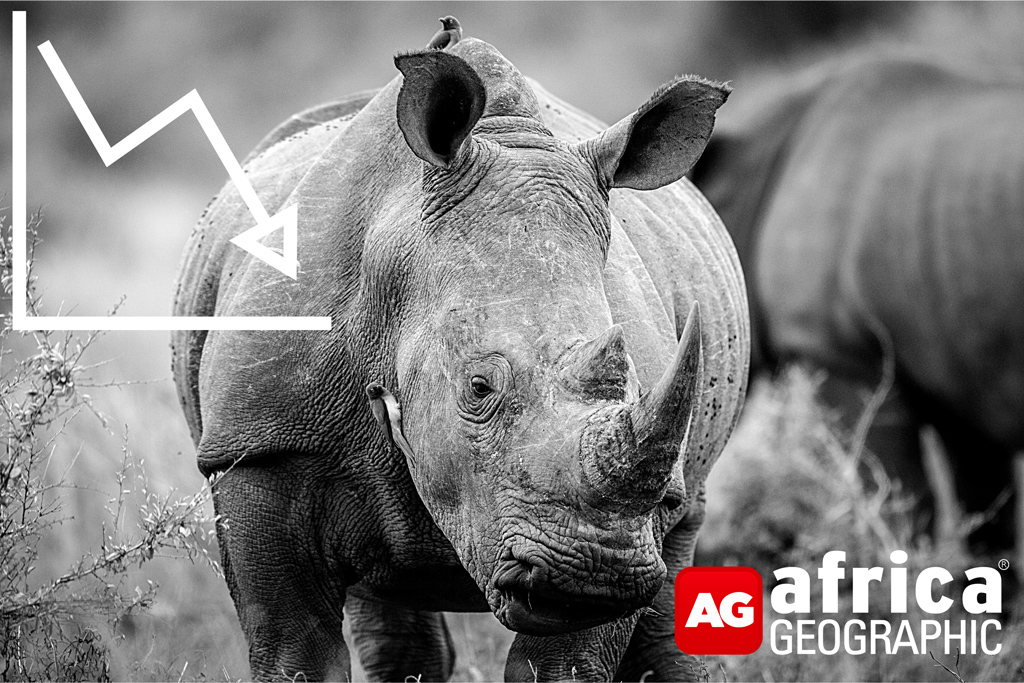
Rhino populations in Kruger National Park continue to decline despite innovative strategies implemented to prevent rhino poaching. The latest population count, reported in the SANParks Annual Report 2022/2023, reveals that the total rhino population has declined by 16.2%, from an estimated 2,458 rhinos in 2021 to 2,060 in 2022.
Despite investing in access control, air support, security staff, specialised detection technology, K9 Units, dehorning and ranger training, 98 rhinos were lost to poaching in Kruger National Park in 2022. This is a decrease of 49.7% in poaching compared to the 195 rhinos lost in 2021.
“Innovative strategies implemented in Kruger National Park, which has historically borne the brunt of this scourge, led to a decline in poaching numbers by 49,74% compared to the previous year,” says Pam Yako, Chairperson of the Board for SANParks.
7.1% of the white rhino population was lost to poaching and 3.4% of the black rhino population.
There were an estimated 1,850 (between 1,711 and 1,988*) white rhinos in Kruger by the end of 2022, compared to the 2,250 (between 1,986 and 2,513*) counted in 2021. For black rhinos, the 2022 survey estimated 210 black rhinos present in Kruger, compared to 208 for the 2021 reporting period*.
(*Editorial note: All population estimates are given a margin of error, as population counts over large areas carry uncertainty. When calculating the percentage decline/increase, these margins of error are included in the statistical analysis. Although the 2022/2023 annual report states that for “the past three years, black rhinos remained at an estimated 210 individuals,” actual estimates from these reporting periods were 208 for 2021 and 202 for 2020.)


SANParks also reported that the lagging effects of drought contributed to the continuing decline in white rhino numbers. In contrast, black rhinos did not experience the drought effect, and births were slightly higher than total losses.
The Kruger National Park Rhino Management Plan zones the park into core areas with suitable rhino habitats. In these core conservation zones, there was an overall decline of 19.58% in the rhino population, “primarily due to white rhinos leaving these areas in response to poaching and moving to known localities of suitable habitat,” according to the report. On a positive note, the black rhino population in these core conservation zones increased by 12% since 2020, and substantial increases in black rhino populations were recorded in certain priority zones.
SANParks referenced an initiative to establish rhino strongholds outside Kruger to encourage range expansion. Furthermore, 702 rhinos were dehorned in Kruger, and by the end of 2022, approximately 70% of the park’s rhinos had no horns. (Dehorning has been highlighted as an effective strategy in reducing poaching).

Despite the decrease in poaching incidents in Kruger, reports have shown a shift in poaching away from the Kruger National Park to private reserves in KwaZulu-Natal. However, no rhinos were lost to poaching in the six other SANPArks-operated parks hosting rhinos (Addo Elephant, Karoo, Mapungubwe, Marakele, Mokala and Mountain Zebra National Parks). The rhino populations in these parks increased by 7%.

The annual report also highlights cause for concern regarding snaring for bushmeat in and around parks. SANParks removed one snare from a black rhino, treated 17 injured white and two black rhinos and recovered five white rhino orphans in Kruger, stating that many of these cases were linked to snaring targeting other species.
SANParks also reported that it has started removing disease-free rhinos from Kruger (cleared of bovine tuberculosis), but “this has limited options and can affect the dynamics between the remaining rhinos.”
While poaching rates have shown a significant decline, an analysis of Kruger National Park’s overall population estimates over the past ten years indicates a continued downward trend in rhino numbers despite an increase in anti-poaching initiatives. In the past ten years, Kruger’s total rhino population has decreased by 78%, from 9,383 in 2013 to 2,060 by the end of 2022.
“It has become evident that South Africa needs a species recovery plan for white rhino that considers the support required for conserving rhino across extensive wildlife systems,” says Minister of the Department of Forestry, Fisheries and the Environment Barbara Creecy. “Partnerships with private rhino owners will be important to the plan. SANParks has been requested to lead the development of such a recovery plan as a key element of its work in this coming financial year.”
Further reading
Read more about the science of keeping Kruger’s rhinos safe.
Read the previous update on rhino populations in Kruger for the 2021 period here.
To comment on this story: Login (or sign up) to our app here - it's a troll-free safe place 🙂.![]()






